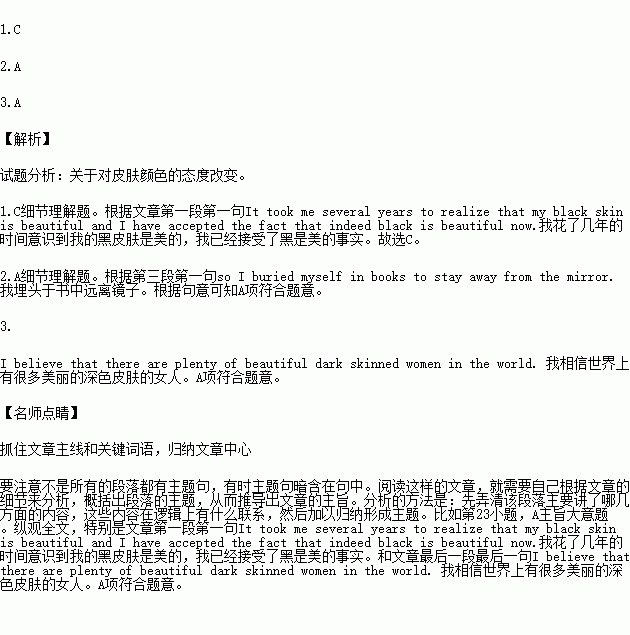题目内容
It took me several years to realize that my black skin is beautiful and I have accepted the fact that indeed black is beautiful now. This skin I have been in for so many years determined my self worth.
I had so many factors “against” me in my mind when I was a little girl. I was a tall, thin, dark skinned girl with a gap tooth smile. Growing up, the only role model that I had was my mother, who has beautiful deep brown complexion (肤色). It’s amazing how I could find beauty in my mother’s complexion but not my own. One of the most outstanding memories of my childhood is the words “Oh, she is so cute for a dark skinned little girl.” People spoke as if I wasn’t in the room, as if I couldn’t hear.
From a young age, I felt ashamed that my black color wasn’t good enough, so I buried myself in books to stay away from the mirror. I knew that my education would and could take me further than my looks. I stopped watching TV, absorbed in my studies and I was happy with my decision. Now I have been admitted to my ideal Coppin State University, which is for black students and has a long history.
It wasn’t until I was at age 16 that I officially decided to fix my deep rooted issue about my dark complexion. I had been brainwashed to subscribe to the European standard of beauty for so many years. I no longer accept this standard, because I set my own. My black is beautiful including my full lips, the wideness of my nose, and the intensity (明亮) of my eyes. I believe that there are plenty of beautiful dark skinned women in the world.
1.When the author was young, she _____.
A. realized the importance of good memory
B. didn’t mind others saying she was black
C. accepted the European standard of beauty
D. didn’t think her mother was very beautiful
2.In childhood how did the author break away from not liking her looks?
A. She turned her attention to her studies.
B. She watched TV and read books.
C. She attended a school for black people.
D. She broke all her mirrors.
3.The author writes the text mainly to tell readers _____.
A. the change of her attitudes toward her complexion
B. varied standards of beauty in different periods
C. how her appearance helped her to succeed
D. why she thinks black skin is beautiful

